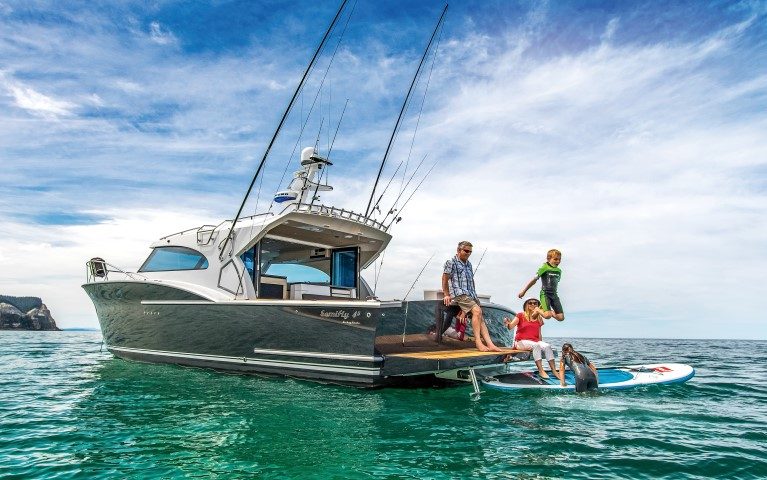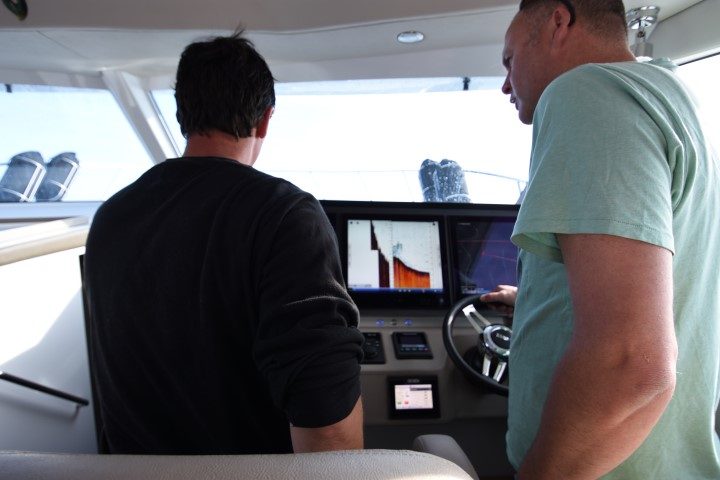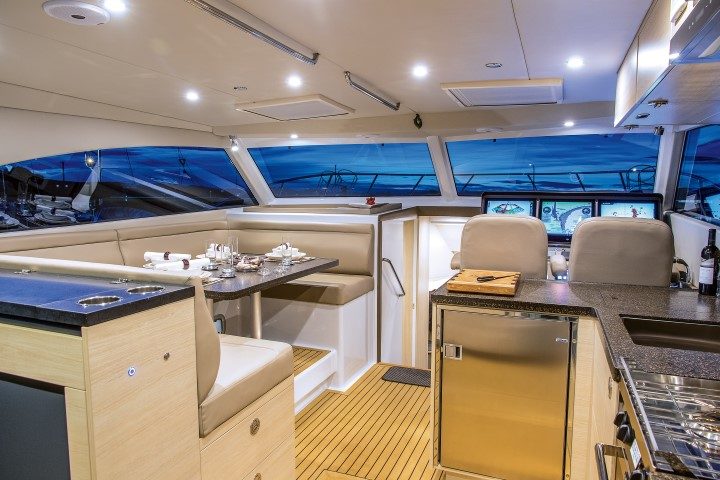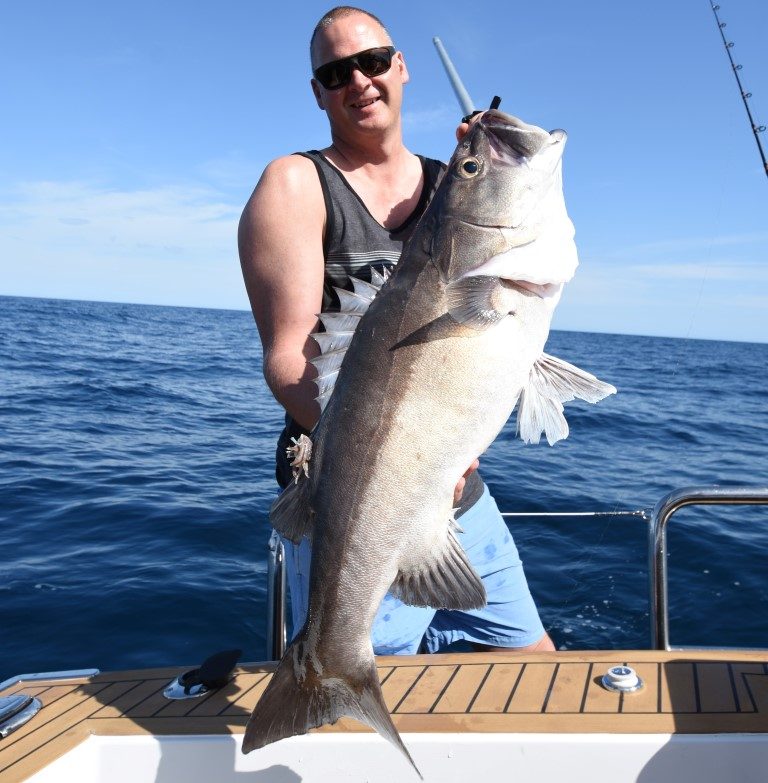She feels really easy and comfortable to sail, even in a good breeze and a chop.

There are sport fishing boats and there are family cruisers, but there aren’t too many family sport fishing cruisers.
The most recent vessel to emerge from Dickey Boats’ Napier facility is the Dickey Semifly 45, another aluminium boatbuilding triumph. In many respects an upscaled. Twin-engined version of Dickey’s popular, multi-award winning Semifly 32, she’s much bigger and even more capable, but equally well designed and built.

With his tongue firmly in cheek, Jason Dickey calls the current crop of popular family-friendly motor launches “lakes and waterways” vessels: they’re just the thing for the sheltered waters of eastern USA’s Intracoastal Waterway, the Mediterranean or Queensland, Australia. Optimised for onboard comfort and entertaining, for many boaters they epitomise the boating lifestyle.
But for dedicated sport fishers such vessels have serious drawbacks. Often the only place from which to wet a line is the swim platform and that’s only when it’s calm. Boaters interested in blue water game fishing have always favoured quite different vessels. Good seakeeping and manoeuvrability, a low centre of gravity, a workable cockpit and the ability to back up on a fish are hallmarks of a good game fishing vessel.
While most such craft are comfortable enough, the emphasis is more likely to be on fishability than luxury accommodation: many US-style sport fishers are cave-like below, often with just a rudimentary galley tucked away under the foredeck, or no overnighting facilities at all. Not surprisingly they don’t always rate with non-fishing members of the family.
First Edition is already a hit with its non-fishing family member. Supremely comfortable without compromising fishability in any way, she’s the latest and largest Semifly model so far; another Semifly 45 is nearing completion in the Dickey Boats’ factory with more pending.
First of many
Commissioned by an enthusiastic Hawkes Bay sport-fisher, Dave keeps First Edition in a Sea Pen drydock in Napier. The Sea Pen helps protect her hull from fouling while its moored, resulting in lower maintenance and fewer haul-outs.
First Edition encompasses all the hallmarks of Dickey’s Semifly line-up: robust engineering, distinctive styling, a beautifully faired and painted hull and solid performance with excellent fuel economy. As befits a vessel of this size and quality, she boasts a luxurious but highly practical custom interior with brilliant indoor-outdoor flow.
From the saloon bulkhead aft, First Edition is a fully blown sport-fisher; forward of the saloon’s extra-large bi-fold doors, she’s all luxury sedan. There’s sleeping accommodation for six in three cabins below - ideal for the owner’s extended family, including adult children and grandchildren. On a boy’s stay-away fishing expedition there’s the option to spread the blokes around, with one of them occupying the settee in the saloon.
The Semifly 45 is a custom design. First Edition’s owners had plenty of input into her layout and specification, often working in tandem with the owners of a second Semifly 45, nearing completion. The two boats share many of the same design features, including Volvo Penta IPS power trains, but also differ considerably. For instance, First Edition has a simple privacy curtain to separate the bunkroom from the companionway, whereas the second 45 has a fully enclosed cabin, and First Edition has an uber-electronics suite courtesy of Electronic Navigation Ltd (see sidebar).

The saloon is light and open. It’s not huge, though it takes full advantage of the vessel’s generous beam, but large windows and the ability to open it completely to the cockpit makes the saloon feel spacious. A marine vinyl upholstered settee wraps around the saloon table offering good sight lines from its raised position. A bar leaner just inside the door on the port side is sure to become a favourite when the rear doors are open and the BBQ island, which also houses the second joystick control and gas locker, is highly practical, demarcating the cockpit from the saloon.

The rear of the island is the backrest for a cockpit bench seat, which is the ideal spot from which to watch lures in the wake. Under the seat is a large fridge-freezer and there’s another good-sized Waeco fridge-freezer under the bar leaner in an expansive storage space extending under the saloon seating area. The freezer slides out on rails and there’s enough room for plenty of fishing gear and other ready-use equipment in this easily accessed locker. It can be closed off with a pull-down roller blind and is completely protected when the doors are closed.
The galley features a Force 10 integrated gas oven and cooktop, Corian worktops, a filtered drinking water faucet and a custom drawer for the Nespresso machine. It’s relatively compact, in keeping with the rest of the saloon’s proportions, but it addresses the cockpit and BBQ island, which with the rear doors open makes it in effect much larger.
Below decks, the cabins are well proportioned and nicely appointed. The bunk room has one full-size and one shorter bunk, the guest cabin has a queen bed extending under the saloon sole and the master in the bows features an island berth. Storage for clothes and other gear is well designed and easily accessible. A shared bathroom with separate shower and electric toilet services all three cabins.
Volvo Penta IPS
The Dickey is the second boat Dave’s owned with Volvo IPS propulsion. First Edition has a pair of IPS 600s, each with 425hp. Fitting Volvo Penta IPS frees up a great deal of space under the saloon sole normally occupied by engines and machinery in shaft-driven vessels. The large service area under the saloon sole is a multi-use space. It houses the vessel’s twin 1100-litre polyethylene fuel tanks, battery banks, Spectra watermaker, WASSP unit and heaps of storage for utility items, cleaning equipment, fishing gear and more.
First Edition’s engines, along with the Whisperpower 4kVA genset, hotwater cylinder and the removable cray pot davit, are tucked away under the cockpit sole, which lifts out of the way on electric rams for superb access to the engine room. The sole is cambered to direct water to the cockpit’s large scuppers and the solidly built port-side transom door opens outwards so it’s safe when the boat is backing up.
When First Edition was commissioned she came in 400kg under the specified design weight and floated absolutely level, something Jason Dickey and his design team are very proud of. The centre of gravity (CG) was exactly where they wanted it. First Edition weighs-in at 12750kg in light ship and reached 34 knots on launching day, fully loaded with four people aboard – faster than her design spec.
The Semifly 45 has a long waterline length due to her distinctive Dickey bow. She cruises efficiently at anywhere between 20 and 29 knots and generally runs flat. At lower speeds Interceptor tabs are used to keep the nose down. One of the attributes of IPS is a very flat fuel burn at cruising speed. First Edition burns pretty much the same amount of fuel per nautical mile at 20 knots as she does at 30, depending on the conditions. Her fuel burn at 28 knots is four litres per nautical mile, both engines combined.
Comfy helm
First Edition’s twin helm seats are extremely comfortable. Featuring folding armrests and fold-away bolsters, they are positioned to provide good all round vision. Underway, vision straight ahead over the bows is excellent. No windscreen wipers are fitted but the screens have freshwater washers and the glass is treated to shed water.
The console is dominated by three large MFD screens which take care of navigation and fish-finding duties (see sidebar). Below is a line of switches and panels for the vessels other equipment, including Volvo Penta’s autopilot and digital display, the main CZone control panel, FLIR camera, spotlight, anchor and more. LED cabin lights can be switched to red for night passages and all the lights are soft start and dimmable.
At docking speeds the boat is steered using the joystick, which allows amazingly precise directional control. At normal speeds, conventional electronic throttle and shift controls are engaged.
The ‘Fish Test’
While First Edition will be used mostly for bottom fishing, Dave and his son Aaron love game fishing in the season, making a pilgrimage to Waihau Bay most years for up to 10 days of stayaway fishing – “A boy’s trip,” says Dave. With that in mind, a Chatfield Engineering game chair slots into the mounting between the deck hatches and Chatfield Engineering game pole bases support Kilwell game poles. First Edition also has a pair of tuna tubes set into the large, glass-fronted live-well under the transom bait station. To enable extended stayaway missions, First Edition can also carry an extra 800 litres of diesel in a bladder between the main fuel tanks.
I joined First Edition, her owner Dave, his son Aaron and Jason and Graeme Dickey in Napier for the new boat’s shakedown run and inaugural fishing trip. We headed to ‘The Ridge’ some 42 nautical miles northeast of the port.

With Dave at the helm, we left Napier just on first light, a batch of scones baking in the oven and Nespresso coffees all round. With flat seas inshore, we cruised at a distance-eating 28 knots on autopilot. Further out a residual swell and sloppy seas slowed First Edition to 25 knots, but the hull continued to do an impressive job of keeping us comfortable. No-one spilled their coffee.
An hour and a half after leaving dock, we slowed to sound out the area we wanted to fish, using First Edition’s impressive electronics suite to scan the bottom for fish and structure more than 100 metres below the boat. The Furuno TZ-Touch module is capable of reliable soundings to 500m with a maximum range of 1000m.
First Edition anchored on the top of the ridge in 70 metres of water, deploying all 150 metres of chain and we commenced fishing. In improving conditions with the wind dropping away, a steady stream of tarakihi, blue cod and groper (hapuku) came aboard, leaving us with a very respectable catch at the end of the day.
First Edition more than fulfilled its fishing brief, easily accommodating five fishers at once, some in the cockpit and some on the swim platform. Dave was able to sit on the side deck, lean against the bulkhead and take it easy in the shade, his electric reel plugged into one of several 12V outlets designed for the purpose. The platform is enclosed with rails at just the right height and angle for safe, comfortable fishing.
Saltwater washdowns both sides of the cockpit kept the decks clean; there are plenty of drink holders, the rod holders are suitable for bottom fishing as well as game fishing and the large swing-out bait boards and brilliant hand washing jets work well.
On the way home we filleted fish at the bait station, which is large enough to accommodate two people at once, while Dave and Jason came to grips with the WASSP multi-beam seabed mapping system. When the dirty work was done and the decks scrubbed, it was back up to cruising speed for a fast and comfortable ride home.
The smile on Dave’s face told the story: First Edition had passed the fish test.
Electronics
First Edition is equipped with CZone vessel monitoring and switching as an integral part of the vessel. All the major systems are controlled from the CZone panel on the dash. The genset, which is on a timer, kicks in automatically when the voltage drops below a certain level and CZone sends texts for low voltage and any other alarms.
Many vessel functions can be controlled via a smart phone or tablet. CZone also monitors motion sensors to detect intruders onboard, texting an alarm.
Dave wanted an electronics suite that allowed him to do it all: game fishing, bottom fishing and cruising, including at night. Electronic Navigation supplied the heart of the system, which is PC-based and can be controlled using a keyboard and mouse. Three large Hatteland displays can show a variety of data, including inputs from the Furuno TZ Touch, DFF3 sounder and GPS plotter, the FLIR camera, Furuno Radar and WASSP multi-beam sonar, a well-proven second generation unit.
One display is normally dedicated to WASSP, another to the conventional sounder, using a 3kW 38kHz transducer, a 2kW 200kHz transducer or both, radar or navigation (chart), with or without radar overlay, or combinations thereof. Radar has Furuno’s target analyzer which shows moving targets in red. An AIS system is included. The third display can be assigned to WASSP or other inputs.
The WASSP works in conjunction with a dedicated Maxsea system to display real-time seabed charting on the right-hand screen, a feature Dave is itching to explore.
This system incorporates multiple transducers for the WASSP and Furuno DFF3 sounder housed in a huge 1.9-metre long pod faired along First Edition’s centerline.
/>
She feels really easy and comfortable to sail, even in a good breeze and a chop.
At first glance the boat appears to be a large centre console, although hidden beneath the console and forward area is a sizeable overnight cabin.
With classic styling, good performance and class-leading ride and handling, there’s a lot to like about the Caribbean 32.
Solar panels on the vast roof help keep the batteries charged.